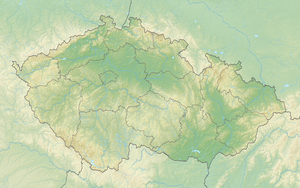Hostýn
| Hostýn | ||
|---|---|---|
|
basilica |
||
| height | 734 m nm | |
| location | Moravia , Czech Republic | |
| Mountains | Hostýnské vrchy | |
| Coordinates | 49 ° 22 '47 " N , 17 ° 42' 7" E | |
|
|
||
| particularities | Pilgrimage mountain | |
The Hostýn (German Hostein ) is a 734 m high pilgrimage mountain in the Hostýnské vrchy ( Hosteiner Mountains ) in the Czech Republic .
geography
The Hostýn is located three kilometers southeast of the town of Bystřice pod Hostýnem in Moravia. At the western foot lies the village of Slavkov pod Hostýnem , in the north Chvalčova Lhota and Chvalčov . To the east of the mountain, the Bystřička forms a deeply cut valley.
history
Around 200 BC A Celtic oppidum is said to have been located on Mount Hostýn .
According to a legend recorded by Bohuslav Balbín , the inhabitants of the surrounding area hid from the attacking Mongols on the mountain in 1241 . They are said to have suffered from a lack of water, so they prayed to the Mother of God . Their prayers are said to have been answered, and a spring sprang up; In addition, a huge storm forced the Mongols to retreat.
The original chapel was probably built at the end of the 16th century. Johann von Rottal had it enlarged in 1653. The chapel "Svatá voda" ( Holy Water Chapel ) was built in 1700 by the Bystritz pastor Provazník at a spring rising from the summit . The basilica "Svatý Hostýn" ( St. Hostein ) was built in 1721–1748 by the master builder and sculptor Thomas Sturm ( Tomáš Šturm ) from Holleschau . The construction was financed by Franz Anton von Rottal . After the church roof and a tower burned out by lightning on September 24, 1769, the damage could be repaired after two years with donations.
During the Josephine reforms , pilgrimages to the Hostein were banned on April 21, 1784. Count Monte dell'Abbate della Rovere , who as the son-in-law of Franz Anton von Rottal had inherited the rule in the meantime, ordered the demolition of the basilica. The towers, the roof and the beams were removed. The walls of the basilica remained in ruins on the mountain. At the beginning of the 19th century, the desire arose to rebuild the pilgrimage church. The resumption of pilgrimages to the legendary mountain corresponded completely to the romanticizing national Czech taste after the appearance of the Königinhof manuscript . In 1840 the owner of the estate, Olivier Laudon , donated 300 guilders to rebuild the basilica. Just in time for the 600th anniversary of the retreat of the Tatars from Hostein, the church was restored in 1841.
In 1887 the Jesuit establishment was completed. In 1895, the pastor Anton Cyril Stojan , who later became the bishop of Olomouc , founded the company "Matice svatohostýnská", which acquired the mountain from Baron Laudon. An inn and a larger hostel were built. At the same time the Svatá voda chapel was restored. The Angel Chapel was built in 1897 and collapsed in 1933 due to lack of repairs and was demolished. In 1898 an observation tower and the chapel "Zum heiligen Kreuz" were built. The Way of the Cross was based on a design by the architect Dušan Jurkovič in 1904–1933.
Like all monastic institutions in Czechoslovakia , the monastery at "Svatý Hostýn" was occupied after the Communists came to power on the night of April 13-14, 1950 and the Jesuits were expelled.
In 1994 a wind turbine was built on the mountain . The basilica was declared a national cultural monument in January 2018 .
Web links
- Svatý Hostýn on the website of the town of Bystřice pod Hostýnem
- Homepage of the pilgrimage site
- The pilgrimage site of Hostein and its checkered history - a contribution by the church historian Rudolf Grulich




